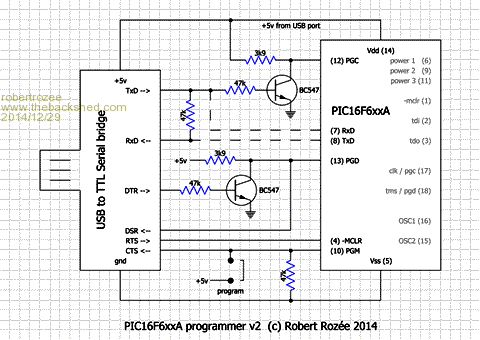
|

|
Forum Index : Microcontroller and PC projects : PIC programming software
| Author | Message | ||||
| larny Guru Joined: 31/10/2011 Location: AustraliaPosts: 346 |
I have used Icprog to programme PICs for many years. However, I recently purchased a 16F684 and it is not covered by Icprog. Does anyone know how I can add a 16F684 to Icprog? If not, does anyone know of other PIC programming software that is free? Any assistance will be appreciated. |
||||
| robert.rozee Guru Joined: 31/12/2012 Location: New ZealandPosts: 2289 |
one option (out of many) is PICPgm: http://picpgm.picprojects.net/index.html it supports the 16F684 according to the device list. i've been trying to contact the author for a few weeks, with little success. it seems that much of the pic programming software out there is long abandoned. cheers, rob :-) |
||||
| JohnS Guru Joined: 18/11/2011 Location: United KingdomPosts: 3659 |
Perhaps PICPrg ? It's free. John |
||||
| larny Guru Joined: 31/10/2011 Location: AustraliaPosts: 346 |
Thanks for the responses. Much appreciated. I was given both the link above in robert.rozee's post & the link below by someone on another forum. http://www.electronicecircuits.com/electronic-software/winpi c-pic-programmer-software-download (I don't know how to make this a link) I installed the winpic one & it works with Windows 7 whereas the one I had from several years ago did not (it worked while I was using XP). Also, when I searched for a newer one from Nigel Goodwin's site, it was the same as the one I had. He does not appear to have been active since the early 2000s. Note the comments in one of the winpic Readmes re the .dev files. I have not tried the http://picpgm.picprojects.net/index.html yet. I intend to test winpic first. Both claim to include the 16F684. |
||||
| geraldfryjr Regular Member Joined: 02/03/2014 Location: United StatesPosts: 61 |
You may be able to find Nigel at http://www.diyaudio.com/forums/ I see him there quite often. He pops in every once in a while and I have asked him if he could share some insight on one of the PIC Controlled audio projects that he mentioned doing, as that was part of what the topic was. But he never responded and disappeared from the discussion all together. :( FWIW jer :) Keep on DIYin' !!!  |
||||
| larny Guru Joined: 31/10/2011 Location: AustraliaPosts: 346 |
Thanks for the reply. I did not want to bother Nigel as he appears to have given up on the Icprog & WinPicProg software. He is the Super Moderator on the http://www.electro-tech-online.com web site. So contacting him is easy. |
||||
| larny Guru Joined: 31/10/2011 Location: AustraliaPosts: 346 |
I have just posted a new post to alert people as to what I discovered about the different programming voltages (Vpp) for some PICs. See PIC Programming voltage Vpp - alert. In short, the 16F684 has a maximum recommended Vpp of 12 Volt. All of the programmers I have seen apply approx 13 Volt! |
||||
| BobD Guru Joined: 07/12/2011 Location: AustraliaPosts: 935 |
Just enough to shorten their life and sell more PICs or is it wrong doco? |
||||
| larny Guru Joined: 31/10/2011 Location: AustraliaPosts: 346 |
You may be right, but I doubt it for two reasons:- 1. I just checked the .dev file of another PIC that I have in stock the - 16F917 and it is the same as the 16F684. 2.It is more than just a typo. You expect a typo to simply have the odd character or two wrong. |
||||
| robert.rozee Guru Joined: 31/12/2012 Location: New ZealandPosts: 2289 |
fyi, i have been in touch with Nigel Goodwin about the possibility of him releasing the source of WinPicProg for further development by others. i believe it is written in delphi 6, and i have a copy of delphi 5 that i could use for continuing development. so far i have received a reply from Nigel, and am now awaiting his views on my request. as the regulars may have guessed, my interest is in adding support for LV programming using this hardware programmer design: 
cheers, rob :-) |
||||
| larny Guru Joined: 31/10/2011 Location: AustraliaPosts: 346 |
Thanks for the info. but I prefer to use the HV programming. Here is a response I received on another forum that may be of interest to those who use HV programming. The PicKits use a programmable boost converter so any voltage up to about 15V can be produced in small increments. But most clones are either fixed or, in some cases, use the unregulated voltage from a serial port (typically about 11V). It is out of specification but works most of the time. |
||||